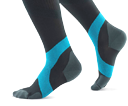| Compression Socks for Running8 October 2015 | John One of the most popular uses of compression garments is for exercise. More and more runners wear compression socks to help improve their run, and many have reported improvements since they started wearing them, so if you’re looking into upgrading your run, compression stockings might be a good place to start. How Do They Work?Compression socks, as the name suggests, apply compression your leg. This helps to increase the natural pumping action of your leg muscles, increasing circulation in your foot. In medical compression stockings this is done to help with venous conditions like varicose veins, but on the feet of runners compression therapy can help improve performance, recovery and protection on your run. Improving PerformanceBecause compression socks boost circulation, it’s thought that they help running performance in two key ways. Firstly, the increased blood flow means the tissue in your legs can get more oxygen faster. This means that you can go for longer distances and harder before the muscles start to build up lactic acid. The other half of how compression socks improve performance is also to do with lactic acid, but in a different way. The increase in circulation compression socks cause is also thought to help deal with lactic acid build-ups as they happen, as it can quickly move the lactic acid, prevent it from pooling and causing more muscle pain. Improving RecoveryCompression socks can also help improve your recovery post-exercise. Because they stimulate blood flow, they can help your legs recover much quicker after a run than they would otherwise. A study published in the Journal of Strength and Conditioning Research in the USA found that runners who wore compression socks for 48 hours after a marathon improved their performance after 2 weeks of recovery by 2.6%. Those who were using the placebo socks saw a 3.4% decline in performance. Wearing compression socks during recovery can also reduce the strength and length of Delayed Onset Muscle Soreness (DOMS) after workouts. Another study, this time in the British Journal of Sports Medicine, found that wearing compression socks after exercises which usually lead to DOMS helped to reduce its effects. The main theory as to why this happens is that the compression reduces the amount of space the muscles have to expand to, which reduces the soreness you can feel after a hard run. Improving ProtectionBecause of the knee-high design of many running compression socks, they offer a natural protection against the elements. There’s nothing worse than doing a trail run, brushing your ankle against a stinging nettle and having to run the rest of the way in pain. Because running compression socks are usually very long (up to the bottom of your knee) they can help defend your lower legs against any unwanted plant life. Compression Socks also offer protection against painful cramps while running. When you're reaching the 35km point of a marathon, the last thing that you need is a nasty cramp in your legs hampering your already-tired body. If you're really serious about improving your performance, this protection against cramp is a must-have. If you’re interested in getting your hands on some compression socks for running, head on over to Compression Stockings and check out our range of Sports Compression Socks. |







